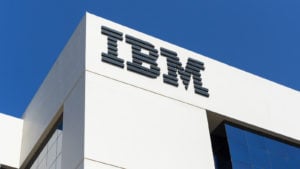International Business Machines (NYSE:IBM) is like a once-massive European soccer team relegated to a lower division.

Stop comparing it to cloud leaders like Microsoft (NASDAQ:MSFT), Alphabet (NASDAQ:GOOG) or even Oracle (NASDAQ:ORCL). At the top of the new league tables sit outsourcers like Accenture (NYSE:ACN), Infosys (NYSE:INFY), Cognizant Technology Solutions (NASDAQ:CTSH) and Wipro (NYSE:WIT).
Even there it’s not burning up the league. Accenture is worth nearly twice what IBM is. India-based Infosys and Wipro are both growing faster. IBM doesn’t want to admit this, but about one-third of its employees are now based in India.
If you’re a soccer fan — which you would undoubtedly call “football” — you might even consider that IBM is the Sheffield Wednesday of technology. But living in Georgia, as I do, calling it “football” would be blasphemous.
Resetting Expectations
American analysts may have trouble with this analogy because American sports is socialist. Revenue is shared, losing teams stay in the league, lazy owners who refuse to invest are coddled.
IBM’s fall has taken decades. It didn’t become complete until late last year when it spun out its managed infrastructure business as Kyndryl Holdings (NYSE:KD). What’s left is expected to do $60 billion in business this year, according to analysts. It’s promising “sustainable mid-single-digit revenue growth,” about $3 billion a year. One thing that’s unclear is how long management can support its $6.56 a share dividend currently yielding 4.89%.
In today’s market that’s not a tech stock. That’s a services company.
IBM relegated itself into this league for the same reason as many soccer teams. It prioritized dividends and stock buybacks throughout the cloud era. It ended September with $50 billion of long-term debt, even after delivering $18 billion in operating cash flow during 2020. Its capital budget over the last four quarters was about $2.3 billion. It sent out nearly $5.8 billion in dividends during 2020. That’s only sustainable in a press release.
What Happens Now?
Under former CEO and now-executive chairman Ginni Rometty, IBM engaged in a long-term liquidation over the last decade. While she has been burnishing her legacy, with two professorships at Northwestern now named for her, the company has continued to sink. The one bright spot in her tenure was the purchase of Red Hat, an open source software company IBM had backed for years. The cloud business unit that now includes Red Hat grew at a meager 2.5% pace in the third quarter, although Red Hat itself grew faster.
Some analysts insist, based mainly on the name, that IBM is poised to turn around. One bull at Bank of America even compared Krishna to Satya Nadella, the now-legendary CEO of Microsoft. That’s like comparing Rice basketball coach Scott Pera to Duke coach Mike Krzyzewski . (The soccer equivalent would be comparing Wednesday coach Darren Moore to Pep Guardiola.) They both do the same job. They just work in different leagues with different expectations.
For IBM, those expectations are for continued Red Hat growth but a death spiral everywhere else. Companies have been abandoning IBM hardware as fast as they can. That’s why UBS recently downgraded the stock. Based on past performance they expect revenue growth of 3%, not the 5% that CEO Krishna has predicted.
The Bottom Line
Like a dowager quietly offloading the family silver, IBM can continue to juggle by offloading operations like Watson Health, touted at the height of Rometty’s reign as the company’s savior.
Inside IBM’s league, Goldman Sachs now prefers Cognizant. While Accenture is growing faster, the market has recognized this with a price to earnings ratio of 37, against 11 for the former Big Blue.
IBM still gets invited to sit in when politicians want to talk to “tech leaders.” It still occasionally buys companies, like Australia’s Envizi. But look closely. The new purchases are start-ups, not established companies. IBM’s “leadership” is a false front, its reputation fading fast in the face of 21st century reality.
On the date of publication, Dana Blankenhorn held long positions in MSFT and BAC. The opinions expressed in this article are those of the writer, subject to the InvestorPlace.com Publishing Guidelines.
Dana Blankenhorn has been a financial and technology journalist since 1978. He is the author of Technology’s Big Bang: Yesterday, Today and Tomorrow with Moore’s Law, available at the Amazon Kindle store. Write him at [email protected], tweet him at @danablankenhorn, or subscribe to his Substack newsletter.
